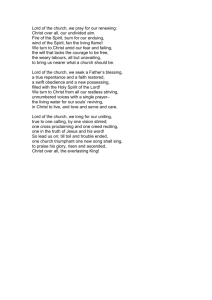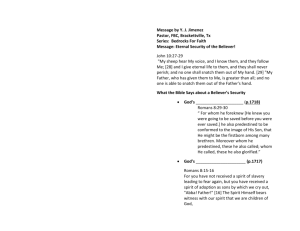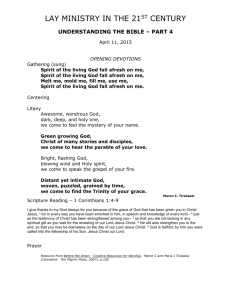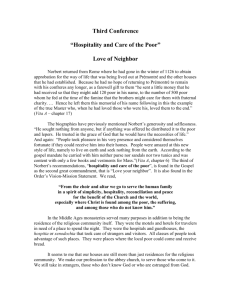New Vision - New Mission? (+ Thomas
advertisement
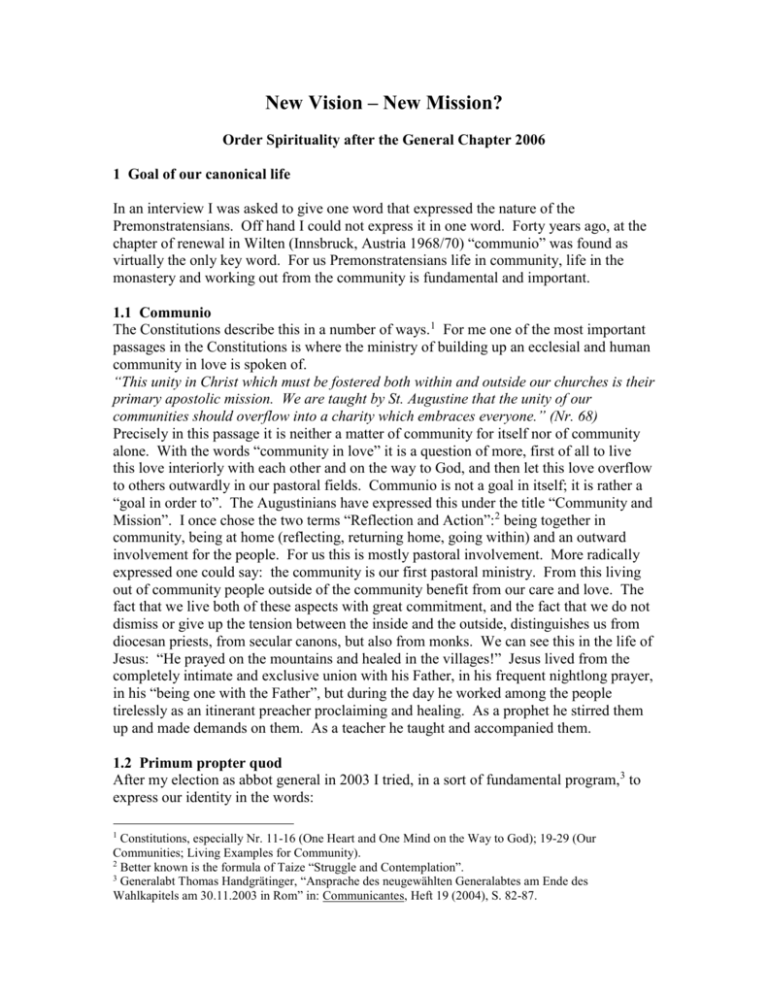
New Vision – New Mission? Order Spirituality after the General Chapter 2006 1 Goal of our canonical life In an interview I was asked to give one word that expressed the nature of the Premonstratensians. Off hand I could not express it in one word. Forty years ago, at the chapter of renewal in Wilten (Innsbruck, Austria 1968/70) “communio” was found as virtually the only key word. For us Premonstratensians life in community, life in the monastery and working out from the community is fundamental and important. 1.1 Communio The Constitutions describe this in a number of ways.1 For me one of the most important passages in the Constitutions is where the ministry of building up an ecclesial and human community in love is spoken of. “This unity in Christ which must be fostered both within and outside our churches is their primary apostolic mission. We are taught by St. Augustine that the unity of our communities should overflow into a charity which embraces everyone.” (Nr. 68) Precisely in this passage it is neither a matter of community for itself nor of community alone. With the words “community in love” it is a question of more, first of all to live this love interiorly with each other and on the way to God, and then let this love overflow to others outwardly in our pastoral fields. Communio is not a goal in itself; it is rather a “goal in order to”. The Augustinians have expressed this under the title “Community and Mission”. I once chose the two terms “Reflection and Action”:2 being together in community, being at home (reflecting, returning home, going within) and an outward involvement for the people. For us this is mostly pastoral involvement. More radically expressed one could say: the community is our first pastoral ministry. From this living out of community people outside of the community benefit from our care and love. The fact that we live both of these aspects with great commitment, and the fact that we do not dismiss or give up the tension between the inside and the outside, distinguishes us from diocesan priests, from secular canons, but also from monks. We can see this in the life of Jesus: “He prayed on the mountains and healed in the villages!” Jesus lived from the completely intimate and exclusive union with his Father, in his frequent nightlong prayer, in his “being one with the Father”, but during the day he worked among the people tirelessly as an itinerant preacher proclaiming and healing. As a prophet he stirred them up and made demands on them. As a teacher he taught and accompanied them. 1.2 Primum propter quod After my election as abbot general in 2003 I tried, in a sort of fundamental program,3 to express our identity in the words: 1 Constitutions, especially Nr. 11-16 (One Heart and One Mind on the Way to God); 19-29 (Our Communities; Living Examples for Community). 2 Better known is the formula of Taize “Struggle and Contemplation”. 3 Generalabt Thomas Handgrätinger, “Ansprache des neugewählten Generalabtes am Ende des Wahlkapitels am 30.11.2003 in Rom” in: Communicantes, Heft 19 (2004), S. 82-87. 2 “Community needs communication, competent leadership and generativity.” - Communication is everything in the community that works toward interaction, exchange, correction and information, conversation and working together. - Leadership and guidance – always safeguarded for us by the control and coresponsibility of the community by means of the council4 and canonry chapter5 – is the ministry of holding the community together, urging it on repeatedly toward its common goal, refocusing and uniting the often divergent energies, in short, strengthening the centripetal energies. - “Generativity” could be described as the ability, as an individual and as a community, to be fruitful, to attract people and inspire them. It is the ability to lead them to believe and to incite them to a life based on that belief; to lead them, each to their own life-vocation, even to a religious life as a member of an order and/or as a priest. As a result, four thematic areas are touched on. I would like to emphasize them. However, they are also constitutive for our Order life. They are the building up of community (communio), and the unity in a community and in the order (communicatio), the right guidance and accompaniment (leadership, auctoritas) and the care for vocational ministry and training (formatio). Finally, everything revolves around community life, around the safeguarding of the structures and competencies, around the qualification of the various duties and future security through a well-educated new generation. At the beginning of the Rule even Augustine is unsurpassed and precise in his expression of this: “The first purpose for which you have come together is to live in unity in the house6 and to be of one mind and one heart on the way to God.”7 Life in the monastery is life in community with the twofold (Augustinian) goal, the building up of a fraternal form of life (communio) and the common striving for God (contemplatio). Canonical monastery life adds to this the third (Norbertine) goal, the building up of an ecclesial community ad extra, among the people, in parishes, at mission stations or in other ministerial projects (actio). Our life is played out in this equilateral triangle of “communio – contemplatio – actio” and we may not give up or shorten any of these sides without running the danger of losing what is proper to us or weakening our identity. 2 Vision – Mission – Statement8 Finally, let us refer to a new and important impetus, which took form slowly in the Spirituality Commission of our Order.9 This was accepted by a great majority at the General Chapter 2006 in Freising. It concerns the “Vision-Mission-Statement”, the attempt to describe and to condense in a short, concise, almost lyrical form the nature of 4 Constitutions, Nr. 115-123 (The Council). Constitutions, Nr. 95-100 (The Canonry Chapter). 6 Ps. 68: 7. 7 Acts 4: 32. 8 “Materia” of the General Chapter 2006 in Freising, M4-D (L-N-E-T-F). 9 Commissio de Vita Canonica et de Spiritu Ordinis (CVCSO) 2000-2006. 5 3 our Order. You could also compare it with a model,10 a brief informative piece for people who want to know about our Order. Just as in the business world the goal and nature of a firm or a group of companies is described with a “corporate identity” so this statement should describe and express the goal and nature of our Order. When this statement was introduced during the General Chapter there was a rather long discussion about concrete phrasing and the stressing of certain points. The individual canonries and circaries of the Order had already spent a full year forming their opinion and dialoguing regarding the content of this statement. Finally a vote was taken and the statement was accepted by a great majority of the chapter fathers. Consequently the result of this vote in the Order is able to find its way into all publications, websites, advertising material, brochures, wherever our Order should be represented or depicted. It can serve as a basis for discussion for house chapters and for days of recollection and be used as a theme for those interested in the monastery and for monastery contact days (“come and see weekends”). Now we can and should work with this “Vision-Mission-Statement”. “Drawn by our merciful and Triune God, we are called as baptized to follow the poor and risen Christ in a radical and apostolic way of life according to the Gospel, the Rule of Saint Augustine and the charism of Saint Norbert, the founder of our Premonstratensian Order. Our way of life is marked by: a lifelong seeking after God through fraternal community, a never-ending conversion by giving ourselves to the church of our profession in communion with the self-emptying of Christ, in imitation of Mary pondering God’s Word, and in ceaseless prayer and service at the altar. From the choir and altar we go to serve the human family in a spirit of simplicity, hospitality, reconciliation and peace for the benefit of the Church and the world, especially where Christ is found among the poor, the suffering, and among those who do not know him. We pray that what God’s Spirit has begun in us may be made perfect in the day of Christ Jesus.” It could be beneficial to speak about this statement in detail. Some clarification should be attempted for each section. Lukas Dikany, “Leitbilddiskussion im Prämonstratenserorden” in: Communicantes, Heft 19 (2004), S. 23-36. 10 4 2.1 Vocation Fundamental to our vocation as Premonstratensians, as with each Christian vocation, is baptism. The choosing and adoption on the part of God, as well as being received into this interior divine community, precedes all our seeking, yearning and responding. “You have not chosen me, but I have chosen you” (Jn 15: 16). We celebrate this adoption by God in the baptism of a newborn child. It is God’s love that calls us into life. It is God’s love that calls us into his faith community, the Church. It is God’s love that summons us finally to a more radical following in the life of an order. Our life is a response, an echo, a reaction to a divine initiative. However, for that reason it is not less original and authentic, but unique and free from the bottom of one’s heart. Our life as Premonstratensians11 stands and falls with our close union with Jesus Christ, the “poor and risen Christ”, as does the life of every Christian and every consecrated religious worldwide. However, we want something of the radical spirit of the early Church to be sensed in our communities. It was in the early Church where people noticed in amazement: “See how they love one another!”12 As Premonstratensians we have our own history and tradition beginning with this early Church spirit as Augustine understood it and described it in his Rule. We continue through the interpretation, the charism and the way of life of an aggressive and radical itinerant preacher Norbert who could inspire people and attract followers. Finally we move on to the concrete shaping of a house in a definite place and time. Our houses are not only characterized by history and tradition but also by always setting out with fresh innovation. Likewise we are personally formed and influenced by particular confreres and their “creative fidelity”. All that together goes to make up our human, ecclesial, consecrated religious and finally our Premonstratensian vocation. And this in turn is colored by the shading of the individual canonry. Our vocation is first of all a call, a challenge and an acceptance by the “merciful and triune God”. Then, thanks to his grace, we want to respond generously to him with our life as Christians and consecrated religious and acknowledge him throughout our life. 2.2 Vision From our call by God and our resultant response of entering a religious community it is now necessary to translate our vision of a religious vocation, our specific view of regularcanonical life, into a concrete way of living. We must do this both as an individual as well as a community. Four practices mark this “fraternal (or sisterly) community”. These have developed out of our Order’s tradition. They are: 1) lifelong seeking after God, 2) never-ending conversion of our life, 3) reflection on the Word of God as Mary could fulfill it, and 4) ceaseless prayer and service at the altar. We could also say that these are the four milestones for our contemplative life in community. 2.2.1 The lifelong seeking after God paraphrases once again this dialogic process that begins with baptism and, we hope, continues until our death. It is the dialogic process of being called and answering. It is the seeking after him who calls us by name, who knows and loves us. It is the seeking after him who gives himself in a way that is not under our 11 Canons Regular, Prämonstratenser-Chorherren, Norbertiner, Norbertine Fathers, norbertijnen, norbertanki, white canons, chanoines de Prémontré. 12 Tertullian, Apologeticum 39, 7. 5 control and who then withdraws again. It is the seeking after him who is nearer to us than we are to ourselves and who, being unobtainable, surpasses everything and us in his transcendence. Here lies the greatest happiness and the deepest mystery of our life and our vocation, with which we never come to an end and with which we will never be complete. God is the total other whose splendor not even the heavens know how to praise, and who at the same time is the one deeply dwelling within us. “For in him we live, we move and we exist” (Acts 17: 28). Here we touch on the contemplative-mystical dimension of our being Christian, which Paul could only express in a stammering way: “It is no longer I who live but Christ lives in me” (Gal. 2: 14). It is seeking and finding, finding and seeking anew, as Augustine says it. It is never possessing and holding, rather maturing and starting over from the beginning. 2.2.2 The never-ending conversion is already touched on in this search movement. In our formula of profession this ministry almost has the character of a fourth vow, the “conversio morum”.13 You could also use this process of conversion as a heading above the three vows. This never-ending conversion and renewal process should play itself out in the three areas of: a poor simple lifestyle (poverty); listening, individually and communally to the call from God (obedience); and, finally, a fraternal form of life that renounces partnership, marriage and children (celibacy dedicated to God, castitas). Here too we never reach the top of the ladder.14 Often enough we must begin anew from below and work upwards again. In the Constitutions this “conversion of life”15 is described by preparedness to forgive a confrere from whom we have distanced ourselves. The confrere is the touchstone, the community the practice field, our relationship to God the destination point of all ascetical, moral and contemplative effort. The strongest expression of this preparedness for conversion is the prostration during profession, this complete handing over to God (trado meipsum), this complete offering to God and to this concrete community (offerens) and this permanent conversion of my personal life and our community way of life (conversio). Here is expressed in a symbolic and liturgical way our approximation to the “self-divesting and kenotic Christ”.16 It is only about the imitation of Jesus and about the humble agreement to follow his path, the outline of his life, therefore becoming more and more like the poor, obedient, chaste Lord. 2.2.3 As a model for this seeking and drawing closer Mary is placed before our eyes. She is always presented to us as a listening, reading, reflecting woman who also seems to call to us: “Whatever he tells you, do it” (Jn 2: 5). The life of Mary centers around the Word of God, so much so that it is assumed in her image: “And the Word was made flesh” (Jn 1:14) through Mary who has opened herself completely to this call, this love, this grace and thus becomes the gateway of the divine reality in this world. That is the virginal and motherly side of this unique woman. Can we emulate or imitate this? However, don’t we know the phrase: “And if Christ were born a thousand times but not in you, the world would remain miserably lost”. Mary is mother of the faith and mother of the Church. She is the model for any birth of God in us and from us. We may allow 13 Constitutions, Nr. 39. In Eastern monasticism the ladder is a symbol for the ascetical struggle and striving. 15 Constitutions, Nr. 41. 16 Cf. Phil. 2: 5-11. 14 6 ourselves confidently to be led and directed by her. There is no other way than to reflect on God’s Word as she did and to ponder it in our heart again and again. 2.2.4 It is precisely in this contemplative-meditative dimension that our prayer takes place and deepens. It is not the abundance of words, but rather the joining together in the never-ending praise of God, which Mary has already intoned in her Magnificat. It is here that our festive choral prayer has its deepest source, in the joyful cry of Mary “My soul praises the greatness of the Lord” (Lk 1: 46), in the cheerful cry of the Lord “I praise you, Father, Lord of heaven and earth” (Lk 10: 21), and in the grateful cry of the Apostles, that they were allowed to suffer injustice for the Lord. And from this grateful song of praise there also grows a solemn liturgy constituted by the Lord: “Do this in memory of me” (Lk 22: 19), which expands to the cosmic and heavenly liturgy of the never-ending worship and glorification of God. Service at the altar in all purity, cleanliness, honor and splendor is a direct “inheritance and ministry” of our Father Norbert. According to St. Benedict nothing should be preferred to this “divine office”. 2.3 Mission So that the vision not slip into the visionary, it is necessary that from this encounter there be a mission. “Contemplata aliis tradere”, “to pass on to others what is reflected on in contemplation” is the motto of the Dominicans. There is no encounter with the divine that would not become mission. All biblical reports about experiences of God indicate this. Whoever falls under God’s influence receives a task, a mandate, a responsibility, a mission: “Go to my brothers and announce to them: I go to my Father and your Father, to my God and your God” (Jn 20: 17b). That is the mandate to Mary Magdalene after her encounter with the Risen One. Mary Magdalene, a woman, becomes the first messenger of the resurrection. That remains the basic mission for us as Christians who were baptized into the crucified and risen Lord Jesus Christ. As Premonstratensians in the white habit, which recalls the angel of the resurrection in the Gospel, we feel especially obligated to this mission. The Statement presents us with four mission areas: our service for reconciliation and peace, our service for the building up of the church and community, our service for the poor, suffering and our mission to those who do not yet know God – four milestones for our pastoral, missionary and active work 2.3.1 Our service for reconciliation and peace is oriented toward St. Norbert, whom our American confreres like to refer to as “minister of peace and concord”. His work was noted for the ability to reconcile people, to establish peace where groups were divided, to take up once again the threads of dialogue and to come to workable solutions. Following the footsteps of our founder would give us here even today a broad field of action – beginning in one’s own monastery – where in this regard there is a good grounding of conflict and reconciliation to be built up and nourished. This is also the case in parishes where we consistently encounter competitive groups or divergent interests, in schools where violence and riots multiply. However, peace work could also be an essential content of our parish ministry in order to assist people toward a reconciled inwardness, toward a life in peace with oneself and the world, but above all in peace with God, the God of peace and reconciliation. We should not leave the field of “inner healing” to 7 therapists but, taking up the angels’ message of peace, “and on earth peace with those in his grace” (Lk 2: 14), we should much more announce true peace to people: “Peace I leave to you, my peace I give to you”. Peace work today is an important part of all political work. Dialogue among religions, the integration process of various cultures, the checking of hunger, sickness and exploitation are only a few key words in this effort. What is our contribution here as Christians and as disciples of Norbert? 2.3.2 Our mission for the building up of church and community follows directly from the vision of a contemplative way of life. What we strive for and live, what we form in love should overflow into the community, into the church where we are sent out to people. “Sent as He” was the pathbreaking article of Abbot Petrus Broeckx of Postel for the General Chapter 1982 in Oostmalle.17 As Premonstratensians we are church builders. Blessed Hugh, the first abbot and abbot general of Prémontré, is usually depicted with a model of a church. As a community we should build up the church in the local community as well, in the parishes, in the various pastoral fields of action. “We should serve the well-being of the church and the world”. That is very generally expressed and leaves much room for play, as we react to the demands and signs of the time and wish to respond to them.18 Two directions are conceivable here. First of all we could actually go out and become involved in working with people on the spot, as has in fact been the case for centuries through parish ministry in the area around the abbeys. Or we could invite the people into our houses, take them into a guest-friendly and modest atmosphere and house and accompany them for a time. Furthermore our choir prayer and our Eucharistic celebrations as canons are not private monastic liturgies, but should be open to the faithful. We pray and celebrate as church, in the church and for the church.19 2.3.3 The question of poverty in our Order life will never be completely answered. The vow of poverty remains more a goad, an exhortation and a challenge. St. Norbert acted very radically and step-by-step gave up all personal and family possessions in order “to follow the naked Christ naked”. A hundred years later St. Francis would again radicalize this detachment from all possessions. Poverty and need is of itself not a virtue. But this detaching oneself from material dependency is a way that can lead us to greater solidarity with the poor, to more sharing, to more sensitivity to real poverty in our surroundings. In addition to glaring material need there is also a spiritual poverty and wretchedness, a spiritual need, a spiritual starvation among people. The needs and the sufferings are diverse and often overtax our possibilities. But there is still the Word of the Lord that is directed to us precisely in this area: “Give them to eat” (Mk 6: 37). Give these people what they want and cry out for. They want food, education, better medical care, more attentive accompaniment in all the crises and vicissitudes of their life, but they also want peace, reconciliation, equality and justice. Petrus Broeckx, “Gesandt wie Er” in : Thomas Handgrätinger (Hrsg.), Gesandt wie Er. Der Orden der Prämonstratenser-Chorherrn heute. Würzburg, 1984, S. 167-185. 18 Constitutions, Nr. 70-72. 19 Constitutions, Nr. 56-58. 17 8 2.3.4 The final mission task, which the Statement formulates, again takes up the life work of St. Norbert. During his life Norbert remained an itinerant preacher who untiringly was on the way to people in order to deliver his message. Immediately after his conversion he did this throughout half of Europe, then as founder of the Order, as archbishop, and finally as imperial politician. His view extended far to the east where he considered beginning a missionary offensive from Magdeburg and creating a new church province. To announce Christ to people who do not know Christ, still do not know him or no longer know him, is today not less relevant and important. The faith seems to evaporate, the transmission of the faith seems no longer to succeed, and the knowledge of the faith seems slowly to dry up. What would a Norbert do today? Surely even today he would break forth from rigid cloistered walls and take himself on the road to people. Today many complain about a “sedentary church” with innumerable conferences, meetings and discussions. How would a dynamic and pilgrim church look, a church that is more interested in people than in itself? Where are the missionary zeal and the Pentecostal breaking out as when the disciples, full of the Holy Spirit, broke open the doors and hastened to people and spoke to them in their own languages? Today this mission could begin right in front of the door of our house, but it must also go worldwide. 2.4 “Dies venit” The final segment of the Statement takes us back to the liturgy of our own profession ceremony, where we sang three times full of dedication and idealism: “Complete, O God, what you have worked in us, through your gracious mercy”.20 All our effort and longing leads to prayer and petition for mercy and support that God himself may bring the work that was begun to completion. It is the common request for the Holy Spirit to bring this about on the day when Christ once again appears. Our Order life has a dynamic and a perspective that we live for him to whom we have given ourselves, that we wait for him to whom we have completely dedicated ourselves, that we might be able to stand before him who has called us into his following. The church as a whole lives in a post-Pentecostal age, in a condition of vigilance and longing, growth and maturation in which the active inspiring role belongs to the Holy Spirit. He will make all things new and will renew the face of the earth. This renewal is prayed for and implored. Thus the group of Apostles – who gathered around Mary, and persisted constantly in prayer in the upper room (Acts 1: 12-14), who then were caught up by storm and fire to become seized by the Spirit of God – is the enduring model for our common life, for our common prayer and for our missionary work among people. 3. Conclusion Does this “Vision-Mission-Statement” now bring something new that we previously had not known, a “new vision”, a “new mission”? The Statement breathes fully our Premonstratensian spirituality, contains something of the early church radicalism and above all breathes the spirit of St. Norbert, to whom credit is due precisely in his reform efforts to actualize the spirit of the early church. This return to the beginning of the church, to the first love, he wanted to have as the basis for his new form of life of canons 20 Constitutions, Appendix I, The Order of Religious Profession in the Order of Canons Regular of Prémontré, p. A-24. 9 regular. Therefore he adopted the Rule of Augustine because he saw in Augustine the best preserver and authority of the early church’s charisma. Appealing and new is surely the vivid language, the concise clarity, the reduction of the “quinque viae”21 to four basic visions, the stronger accentuation on the missionary aspect vis-à-vis people, who do not know Christ (any more). The prelude with the theology of baptism makes people sit up and take notice. This is the foundation of our entire Christian life in the Order; this, as well as the Pentecostal-pneumatic arrangement, which must embrace our entire life in the Order, beginning with baptism and hopefully completed on the day of the Lord. For me it is significant that this statement ends in a prayer for completion in Christ through the Holy Spirit. And therefore here too a prayer should stand at the end. “God of mercy, in your eternal wisdom you called your servant, Norbert, to set off on a journey of faith as itinerant preacher, as initiator of our Order of Prémontré, as archbishop in Magdeburg, with your word of truth in his heart and on his lips. Norbert invited us – men and women, priests and lay people – to join him in the canonical life in service to the people of God. As we remember his vision and mission we ask you to breathe the Spirit of the risen Christ into our hearts and minds. Re-create us, so that we might faithfully and joyfully proclaim the gospel of reconciliation and peace through the same Christ our Lord. Amen.”22 + Thomas Handgrätinger Abate Generale 21 1) Laus Dei in choro 2) Cultus Eucharisticus 3) Cultus Beatae mariae Virginis 4) Zelus animarum 5) Jugis poenitentiae spiritus. 22 Cf. the prayer for the 800 year celebration of Prouilhe. Liam Walsh OP, “Light for the Church”, in Religious Life Review 45 (2006) XI-XII, p. 357-382.
